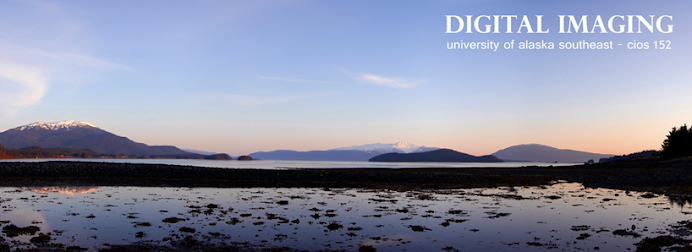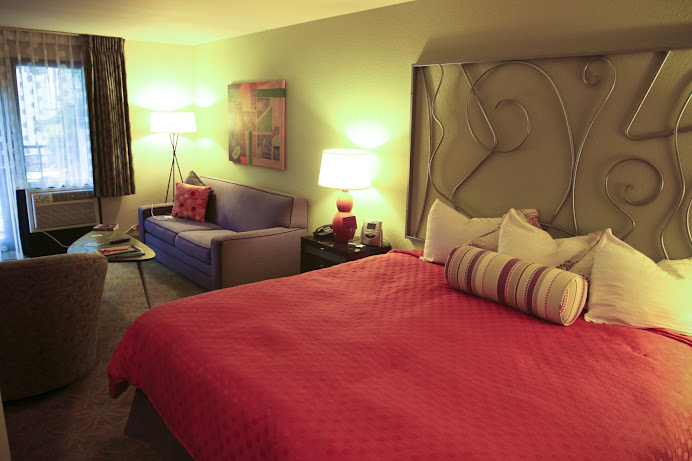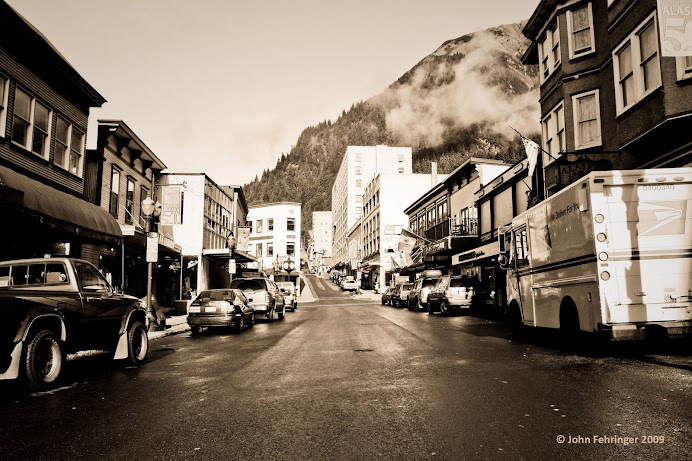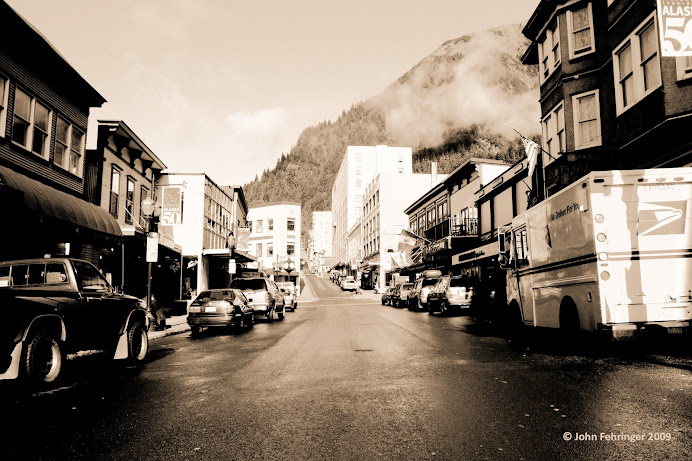
Monday, April 27, 2009
Photoshop Tutorial: Using the Levels and Selective Color Tools

Sunday, April 19, 2009
Project 7: Layer Masks
I feel like I am just getting started with layer masks and have made some good initial progress. This assignment really helped me to get the basics down. Developing it will take some practice like everything else in PS. If you have time to check out the videos I posted to YouTube I think they are an effective way to share our experiences. The one John posted definitely helped me to better understand these concepts.
Monday, April 6, 2009
Project 6: Photo Stitching
This next one is actually 7 photos stitched together. It’s more dramatic, really giving the panoramic feel. And while you can’t fully see the mountains, I really like the effect the clouds bring to the composition. The adjustments in this one are basically the same as the first. I turned up the contrast a little, and also turned up the magenta in the blue channel to make the sky pop more, giving better contrast to the clouds.
This series I took on a frosty morning before work. It’s 5 photos stitched together. Same techniques and adjustments as the previous one, the only difference being I did adjust levels. While it doesn’t have the brilliant blue sky of, I really like the early morning feel, and the shape of the clouds lit up by the sun. With pictures I’m always trying to capture the feel that I had when I was taking them. I believe I accomplished that with this one. Every morning as I walk to work I always find myself wishing I could share the beauty of this view with others. I’m really excited about this photo stitching technique because it helps to do that, to capture the essence of what I am seeing. I was reading about panorama shots on some website and it was saying that these types of photographs are so effective because they almost match the eye’s natural field of vision. You really get the feeling of being there. I did have some trouble on the left side with the sun in my lense. The little rainbow effect in the rightmost frame I like, but you can also see a lighter vertical stripe to the left of that. I wasn't able to correct it without losing what I felt was too much of the remaing detail. If anyone has suggestions that would be appreaciated. Or maybe it waorks that way I'm not sure.
So I did one more cause I was on a roll and getting the technique down pretty well. This one was more of a challenge because of the tripod-in-snow issue I mention earlier. The pictures on the right side especially (I think this one was 6 total) were really crooked, and required a lot of adjusting/lining up to fix. I made the canvas extra tall and stitched them together that way (it ended up at a diagonal.) Then, when I had that done I flattened the image and Transform-Rotated the whole thing before cropping. I had tried straightening each one individually as I had done on the previous ones but they were just too crooked, it was giving me problems. I think this way is faster and more accurate.
With text
All of these images I created at 300 dpi with the hope of getting poster prints of them done. For the uploaded files reduced them to 72 dpi and then reduced that image by 20%. This was a great project and I plan to do many more panorama compositions.
Thursday, March 26, 2009
Filters: Color and Contrast
With this goal in mind I tried about 10 different filters with variations of each one. I picked the best 3 from those. While I did keep my original goal in mind for each, I also did what I always have done when using filters on my photos, which is basically pick what looks good. I don't know how to define it much more than that. The 3 filters I ended up using for my orginal goal/them are Dark Strokes, Sumi-e and Accented Edges. The Glowing Edges one I threw in as an abstract departure. Its been done I know, but I've always liked it, and I like how it emphasizes the bottles and their colors. I recommend clicking to enlarge each one to get the best feel for its effect.
Original Photo
Accented Edges Filter
-enhances the texture of the wall, shape and plastic feel of the bottles. enchances color, shadows and spots of light on the wall-

Wednesday, March 25, 2009
Filters: Smart Sharpen and Ink Outlines
Saturday, February 28, 2009
Project 4: Zac Tile
After opening the Zac Tile file, I doubled the size of my canvas and selected around the outline with the rectangular marquee tool. I then cloned and moved the selection with Ctrl + Alt + Shift and flipped it horizontal with the Free Transform command. Then I selected the black outlines by loading the channel as a selection (wish I had known that for the last project) and made them a new layer. At this point I made about 10 duplicate images and started experimenting.
Compositions
The first thing I tried with the brush tool was Color Dynamics because it was my favorite from the book assignment. I tried a variety of diameter, hardness, shape dynamic, and color dynamic settings. I ended up using a brush diameter of 46 pixels with Hue jitter- 92% and Saturation jitter – 46%. I got the best multicolored effect with red selected for brush color.
For the composition with the white background I moved the brush quickly across the lines to get a thin striped effect.
For the composition with the black background I moved the brush more slowly and single clicked each circle in the frame to get one color per circle. For the background I left the color dynamic settings active and switched to black. I then changed to the background layer and filled it in. This increased the contrast of the colored lines and added texture to the background.
For the fully colored composition, I added the color fill layer and used the custom colors loaded from the file that came with the book. I used the paintbucket tool set to ‘all layers’ with tolerance set to 100, to assure coverage in the corners and other small areas. In the end I only had to zoom in and fill a few pixels it had missed. I used as many colors as possible (sticking to my multicolored theme) but left the inside of the frame white to contrast the colored circles within it. At the end this picture felt a little flat and I wanted to add some depth. I experimented with different filters until I found the ‘plastic wrap’ one. It gave me the effect I was looking for, almost like plastic blocks were put together to make the lions face.
Layer Trouble
At some point I messed up the layers so that any green color I selected showed as dark green. I never did figure out why, but it went away once I flattened the image which is why I assume it was related to layers. That wasn’t the only layer related problem I had. I wanted to make a layer to separate the frame from the face. I selected the frame, copied it, and went to Layer -- > New -- > Layer via copy. It created the layer but when I went to paint on it, the paint showed up in the thumbnail but not on my image. Maybe I should have created a New fill layer? Or maybe it was the layer hierarchy I had wrong. Not sure.
Friday, February 13, 2009
Project 3: Making Selections
Project 3: Selection Mania
I used the rectangular marquee tool to make four large rectangles while holding the shift key. Then I removed parts of them with the single row marquee tool while holding the alt key to form the squares and to make the shapes more even. I made the triangles with the polygonal lasso tool. This took me a few tries but I got it eventually.
For the circle in the center the biggest help was the ‘spacebar’ trick he taught us in the book, which lets you pause and move the selection. I was having a hard time centering it before I learned that.
Project 3: Dance1
This was a good introduction to doing selections and many other Photoshop tools.
To make my selections for this project I ended up zooming in and using the magnetic lasso tool. Of all the selection tools I tried from the book, this was the one I could get the most accuracy with. I tried the quick selection tool first, but it always ended up leaving out small sections of the face. I tried adjusting the brush diameter and hardness to correct this like we learned with the giraffe from the textbook but didn’t have much luck.
To resize the head I went to Edit – Free Transform. One of the cool things I discovered here was, since these were profile shots, I could change which way the head was facing to match the target picture. The photo I used for the selection was actually taken with me facing the opposite direction
Then Image --> Adjustments --> Black & White. I then used Brightness/Contrast to match my head more closely to the source photo. Mostly I upped the brightness.
Our heads were shaped differently so there were parts of the old head sticking out. I used the clone stamp tool to get rid of those. At first I couldn’t figure out how to use the clone stamp tool so I opened the picture in Camera Raw and used the heal tool which worked OK. But once I figured it out the clone stamp tool worked the best.
To get my neck to appear as if it was inside the collar and bowtie I created another layer from a selection of the bowtie.
One problem I had was a slight halo of white around my head which appeared when I changed the Brightness and contrast settings. I tried to adjust the Blending option to correct this but got a little lost. Everything seemed too drastic a change. This is something I need to work on more but overall I’m happy with the results.
Project 3: Dance2
For this one I used the same techniques detailed in dance1 with one big difference. The white shutters behind the dancers were problematic. The clone stamp solution from the previous picture wasn’t going to work for this one. So I zoomed in around the head and used the rectangular marquee tool to make selections of the shutters which I copy/pasted over the head. When I got too many layers I flattened the image and repeated the process. This took some practice and at first I got confused with the different layers but I figured it out eventually.
I then used the magnetic lasso to select the head in different photo of myself. I used refine edge and adjusted the contrast to 20 and Feather to 1.0. Refine edge is a step I missed on the Dance1 photo. I realize now it could have removed the small white halo. At that point though I had already flattened the dance1 image and was happy with how it looked, but it’s something to remember for next time. I also used Edit --> Transform --> Rotate to angle my head so that I was better facing the other dancer. I selected and created a separate layer for the collar/necktie and positioned it. Brightness/contrast to match the source picture, flattened it and I was done. I think it came out better than the first one but I’m happy with both of them.
Conclusion
The selection mania was a good way to start to get familiar with the selection tools. Both of the dancer projects got me a lot more familiar with Photoshop. I was experimenting and looking through all the lists to find tools that would work.
I also learned that there is a hierarchy to the layers palette that determines which layers appear in front of, or on top of each other. This seems fairly obvious now that I know it but took me some time to figure out.
The 'Drawing Precise Curves' section of the book lost me about halfway through. I've been over it twice now and can't get it to do what it's suppose to. I get the path drawn around the pelican's beak (after about 4 trys), but when when it gets to the copying paths between layers part, I can't get that to work.

































.jpg)



